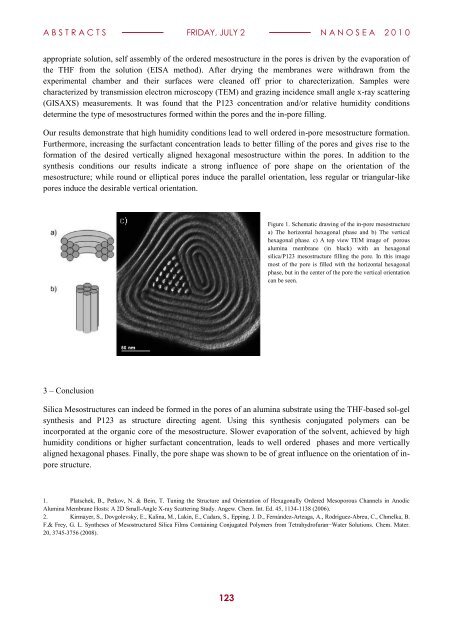book of abstracts - IM2NP
book of abstracts - IM2NP
book of abstracts - IM2NP
Create successful ePaper yourself
Turn your PDF publications into a flip-book with our unique Google optimized e-Paper software.
A B S T R A C T S FRIDAY, JULY 2 N A N O S E A 2 0 1 0<br />
appropriate solution, self assembly <strong>of</strong> the ordered mesostructure in the pores is driven by the evaporation <strong>of</strong><br />
the THF from the solution (EISA method). After drying the membranes were withdrawn from the<br />
experimental chamber and their surfaces were cleaned <strong>of</strong>f prior to charecterization. Samples were<br />
characterized by transmission electron microscopy (TEM) and grazing incidence small angle x-ray scattering<br />
(GISAXS) measurements. It was found that the P123 concentration and/or relative humidity conditions<br />
determine the type <strong>of</strong> mesostructures formed within the pores and the in-pore filling.<br />
Our results demonstrate that high humidity conditions lead to well ordered in-pore mesostructure formation.<br />
Furthermore, increasing the surfactant concentration leads to better filling <strong>of</strong> the pores and gives rise to the<br />
formation <strong>of</strong> the desired vertically aligned hexagonal mesostructure within the pores. In addition to the<br />
synthesis conditions our results indicate a strong influence <strong>of</strong> pore shape on the orientation <strong>of</strong> the<br />
mesostructure; while round or elliptical pores induce the parallel orientation, less regular or triangular-like<br />
pores induce the desirable vertical orientation.<br />
Figure 1. Schematic drawing <strong>of</strong> the in-pore mesostructure<br />
a) The horizontal hexagonal phase and b) The vertical<br />
hexagonal phase. c) A top view TEM image <strong>of</strong> porous<br />
alumina membrane (in black) with an hexagonal<br />
silica/P123 mesostructure filling the pore. In this image<br />
most <strong>of</strong> the pore is filled with the horizontal hexagonal<br />
phase, but in the center <strong>of</strong> the pore the vertical orientation<br />
can be seen.<br />
3 – Conclusion<br />
Silica Mesostructures can indeed be formed in the pores <strong>of</strong> an alumina substrate using the THF-based sol-gel<br />
synthesis and P123 as structure directing agent. Using this synthesis conjugated polymers can be<br />
incorporated at the organic core <strong>of</strong> the mesostructure. Slower evaporation <strong>of</strong> the solvent, achieved by high<br />
humidity conditions or higher surfactant concentration, leads to well ordered phases and more vertically<br />
aligned hexagonal phases. Finally, the pore shape was shown to be <strong>of</strong> great influence on the orientation <strong>of</strong> inpore<br />
structure.<br />
1. Platschek, B., Petkov, N. & Bein, T. Tuning the Structure and Orientation <strong>of</strong> Hexagonally Ordered Mesoporous Channels in Anodic<br />
Alumina Membrane Hosts: A 2D Small-Angle X-ray Scattering Study. Angew. Chem. Int. Ed. 45, 1134-1138 (2006).<br />
2. Kirmayer, S., Dovgolevsky, E., Kalina, M., Lakin, E., Cadars, S., Epping, J. D., Fernández-Arteaga, A., Rodríguez-Abreu, C., Chmelka, B.<br />
F.& Frey, G. L. Syntheses <strong>of</strong> Mesostructured Silica Films Containing Conjugated Polymers from Tetrahydr<strong>of</strong>uran−Water Solutions. Chem. Mater.<br />
20, 3745-3756 (2008).<br />
123

















